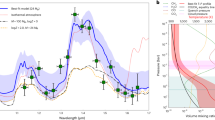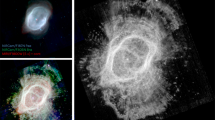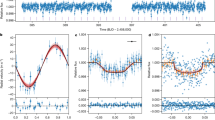Abstract
Planetary nebulae are ionized clouds of gas formed by the hydrogen-rich envelopes of low- and intermediate-mass stars ejected at late evolutionary stages. The strong UV flux from their central stars causes a highly stratified ionization structure, with species of higher ionization potential closer to the star. Here, we report on the exceptional case of HuBi 1, a double-shell planetary nebula whose inner shell presents emission from low-ionization species close to the star and emission from high-ionization species farther away. Spectral analysis demonstrates that the inner shell of HuBi 1 is excited by shocks, whereas its outer shell is recombining. The anomalous excitation of these shells can be traced to its low-temperature [WC10] central star whose optical brightness has declined continuously by 10 magnitudes in a period of 46 years. Evolutionary models reveal that this star is the descendant of a low-mass star (≃1.1 M⊙) that has experienced a ‘born-again’ event1 whose ejecta shock-excite the inner shell. HuBi 1 represents the missing link in the formation of metal-rich central stars of planetary nebulae from low-mass progenitors, offering unique insight regarding the future evolution of the born-again Sakurai’s object2. Coming from a solar-mass progenitor, HuBi 1 represents a potential end-state for our Sun.
This is a preview of subscription content, access via your institution
Access options
Access Nature and 54 other Nature Portfolio journals
Get Nature+, our best-value online-access subscription
$29.99 / 30 days
cancel any time
Subscribe to this journal
Receive 12 digital issues and online access to articles
$119.00 per year
only $9.92 per issue
Buy this article
- Purchase on SpringerLink
- Instant access to full article PDF
Prices may be subject to local taxes which are calculated during checkout



Similar content being viewed by others
References
Duerbeck, H. W. et al. The rise and fall of V4334 Sagittarii (Sakurai’s object). Astron. J. 119, 2360–2475 (2000).
Hajduk, M. et al. The real-time stellar evolution of Sakurai’s object. Science 308, 231–233 (2005).
Hu, J. Y. & Bibo, E. A. Discovery of a new cool WR star in a low excitation planetary nebula. Astron. Astrophys. 234, 435–438 (1990).
Pollacco, D. L. & Hill, P. W. The planetary nebula surrounding the WC 11 star IRAS 17514–1555. Mon. Not. R. Astron. Soc. 267, 692–696 (1994).
Hamann, W.-R. in Hydrogen Deficient Stars Vol. 96 (eds Jeffery, C. S. & Heber, U.) 127 (Astronomical Society of the Pacific, San Francisco, 1996).
Peña, M. The low excitation planetary nebulae HuDo 1 and HuBi 1 and their [WC10] central stars. Rev. Mex. Astron. Astr. 41, 423–433 (2005).
Leuenhagen, U. & Hamann, W.-R. Spectral analyses of late-type [WC] central stars of planetary nebulae: more empirical constraints for their evolutionary status. Astron. Astrophys. 330, 265–276 (1998).
Corradi, R. L. M., Schönberner, D., Steffen, M. & Perinotto, M. Ionized haloes in planetary nebulae: new discoveries, literature compilation and basic statistical properties. Mon. Not. R. Astron. Soc. 340, 417–446 (2003).
Draine, B. T. & McKee, C. F. Theory of interstellar shocks. Annu. Rev. Astron. Astr. 31, 373–432 (1993).
Perea-Calderón, J. V., García-Hernández, D. A., García-Lario, P., Szczerba, R. & Bobrowsky, M. The mixed chemistry phenomenon in Galactic Bulge PNe. Astron. Astrophys. 495, L5–L8 (2009).
Naito, H. et al. Five-year optical and near-infrared observations of the extremely slow nova V1280 Scorpii. Astron. Astrophys. 543, A86 (2012).
Clayton, G. C. The R Coronae Borealis stars. Publ. Astron. Soc. Pac. 108, 225–241 (1996).
Williams, P. M. Dust formation around WC stars. Proc. IAU 163, 335 (1995).
Williams, P. M. Eclipses and dust formation by WC9 type Wolf–Rayet stars. Mon. Not. R. Astron. Soc. 445, 1253–1260 (2014).
Acker, A. & Neiner, C. Quantitative classification of WR nuclei of planetary nebulae. Astron. Astrophys. 403, 659–673 (2003).
Blöcker, T. Evolution on the AGB and beyond: on the formation of H-deficient post-AGB stars. Astrophys. Space Sci. 275, 1–14 (2001).
Schönberner, D. Asymptotic giant branch evolution with steady mass loss. Astron. Astrophys. 79, 108–114 (1979).
Zijlstra, A. A. The infrared [WC] stars. Astrophys. Space Sci. 275, 79–90 (2001).
Acker, A., Gesicki, K., Grosdidier, Y. & Durand, S. Turbulent planetary nebulae around [WC]-type stars. Astron. Astrophys. 384, 620–628 (2002).
García-Rojas, J. et al. Analysis of chemical abundances in planetary nebulae with [WC] central stars. II. Chemical abundances and the abundance discrepancy factor. Astron. Astrophys. 558, A122 (2013).
Gesicki, K., Zijlstra, A. A. & Miller Bertolami, M. M. The mysterious age invariance of the planetary nebula luminosity function bright cut-off. Nat. Astron. 2, 580–584 (2018).
Steffen, W. et al. Shape: a 3D modeling tool for astrophysics. IEEE Trans. Vis. Comput. Graphics 17, 454–465 (2011).
Frew, D. J., Parker, Q. A., & Bojičić, I. S. The Hα surface brightness-radius relation: a robust statistical distance indicator for planetary nebulae. Mon. Not. R. Astron. Soc. 455, 1459–1488 (2016).
Hamann, W.-R. & Gräfener, G. Grids of model spectra for WN stars, ready for use. Astron. Astrophys. 427, 697–704 (2004).
Hainich, R. et al. Wolf-Rayet stars in the Small Magellanic Cloud. I. Analysis of the single WN stars. Astron. Astrophys. 581, A21 (2015).
Reindl, N. et al. The rapid evolution of the exciting star of the Stingray nebula. Astron. Astrophys. 565, A40 (2014).
Monet, D. G. et al. The USNO-B Catalog. Astron. J. 125, 984–993 (2003).
Sutherland, R. S. & Dopita, M. A. Effects of preionization in radiative shocks. I. Self-consistent models. Astrophys. J. Suppl. S. 229, 34 (2017).
Althaus, L. G. et al. The formation and evolution of hydrogen-deficient post-AGB white dwarfs: the emerging chemical profile and the expectations for the PG 1159-DB-DQ evolutionary connection. Astron. Astrophys. 435, 631–648 (2005).
Miller Bertolami, M. M. New models for the evolution of post-asymptotic giant branch stars and central stars of planetary nebulae. Astron. Astrophys. 588, A25 (2016).
Battich, T., Miller Bertolami, M. M., Córsico, A. H. & Althaus, L. G. Pulsational instabilities driven by the ∈ mechanism in hot pre-horizontal branch stars I. The hot-flasher scenario. Astron. Astrophys. 614, A136 (2018).
Clayton, G. C. et al. Evolution of the 1919 ejecta of V605 Aquilae. Astrophys. J. 771, 130 (2013).
Acknowledgements
Some of the data presented in this article were obtained with ALFOSC, which is provided by the Instituto de Astrofísica de Andalucía (IAA) under a joint agreement with the University of Copenhagen and NOTSA. The Nordic Optical telescope (NOT) is installed in the Spanish Observatorio del Roque de los Muchachos of the Instituto de Astrofísica de Canarias, in the island of La Palma (Spain). This article is also based on observations carried out at the Observatorio Astronómico Nacional on the Sierra San Pedro Mártir (OAN SPM), Baja California, Mexico. We thank the daytime and night support staff at the OAN SPM for facilitating and helping obtain our observations. A.A. and C.M. acknowledge support through the CONACyT project CONACyT-CB2015-254132. G.R.-L. acknowledges support from Universidad de Guadalajara, Fundación Marcos Moshinsky, ProMoFID2018 and CONACyT (grant A1-S-12258). L.S. acknowledges support from PAPIIT grant IA-101316 (Mexico). L.F.M. is supported by Ministerio de Economía, Industria y Competitividad (Spain) grants AYA2014-57369-C3-3 and AYA2017-84390-C2-1-R (cofunded by FEDER funds). M.A.G. acknowledges support of the grant AYA 2014-57280-P, cofunded with FEDER funds. M.M.M.B. is partially supported through ANPCyT grant PICT-2016-0053 and MinCyT-DAAD bilateral cooperation program through grant DA/16/07. S.A.Z. was supported by the ITE-UNAM agreement 1500-479-3-V-04.
Author information
Authors and Affiliations
Contributions
M.A.G. planned the research project, programmed the observations, wrote the main body of the manuscript, and organized the writing of some subsections. A.A. performed the MAPPINGS simulations, C.M. the CLOUDY ones, and both devised the excitation nature of the inner and outer shells. C.K. estimated the ionizing flux necessary for the inner and outer shells. G.R.-L. reduced the imaging data and contributed to the analysis of the time evolution of the central star. H.T. analysed the spectrum of the central star using PoWR to determine its stellar parameters and abundances. L.S. and G.R.-L. obtained and reduced the high-dispersion spectroscopic observations, and together with L.F.M. and S.A.Z. analysed them using SHAPE. M.M.M.B. devised the post-AGB evolutionary scenario and computed the LPCODE VLTP evolutionary sequences. X.F. reduced the spectroscopic data and carried out the analysis of one-dimensional spectra and spatial profiles of emission lines. All authors contributed to the discussion of the different sections of this work.
Corresponding author
Ethics declarations
Competing interests
The authors declare no competing interests.
Additional information
Publisher’s note: Springer Nature remains neutral with regard to jurisdictional claims in published maps and institutional affiliations.
Supplementary information
Supplementary Information
Supplementary Table 1, Supplementary Figures 1–6
Rights and permissions
About this article
Cite this article
Guerrero, M.A., Fang, X., Miller Bertolami, M.M. et al. The inside-out planetary nebula around a born-again star. Nat Astron 2, 784–789 (2018). https://doi.org/10.1038/s41550-018-0551-8
Received:
Accepted:
Published:
Issue Date:
DOI: https://doi.org/10.1038/s41550-018-0551-8



